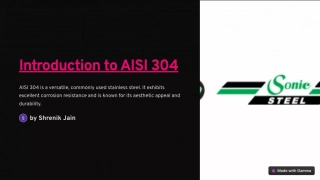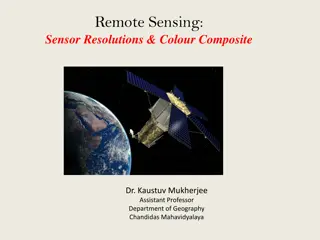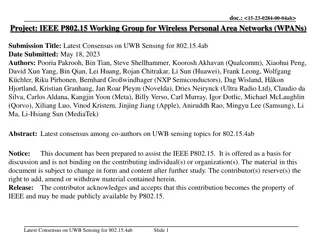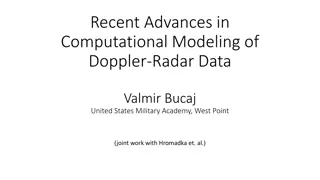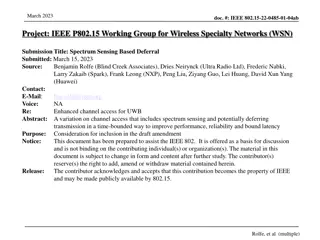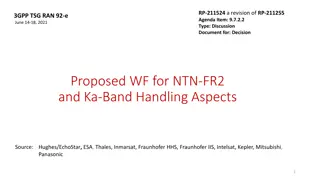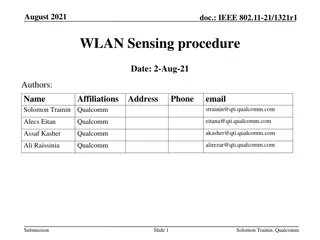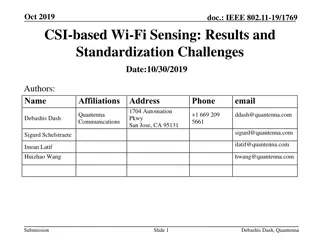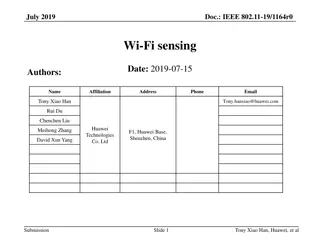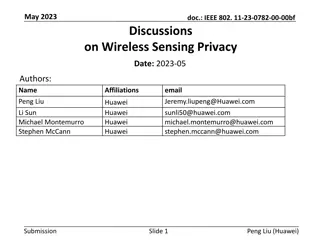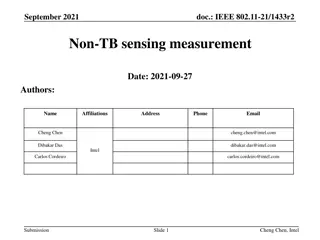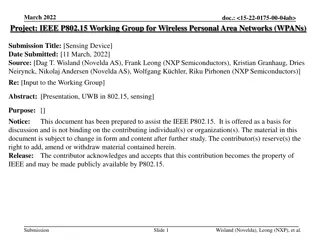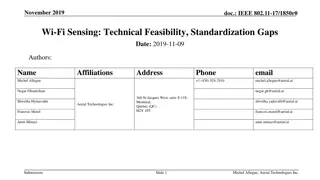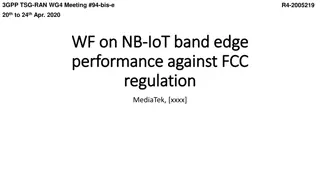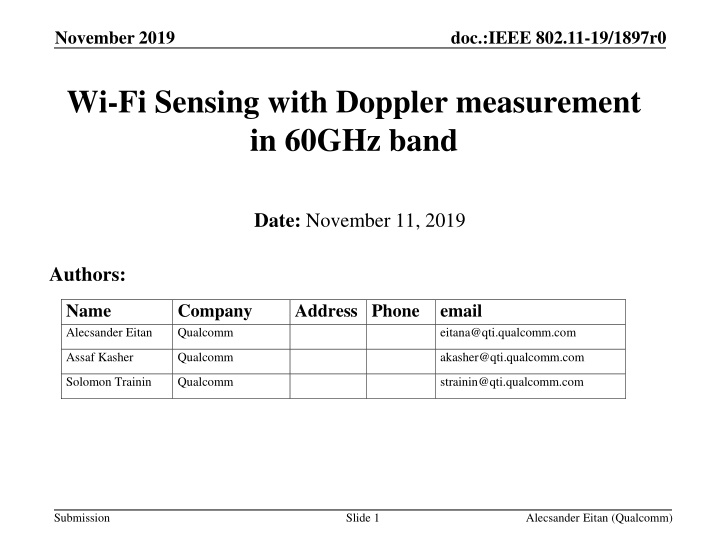
Wi-Fi Sensing with Doppler Measurement in 60GHz Band
"Explore how Doppler measurement in the 60GHz band enables Wi-Fi sensing for detecting non-static targets, identifying and tracking objects, and detecting micro-movements. The benefits of Doppler information and its application in radar technology are discussed in this document."
Download Presentation

Please find below an Image/Link to download the presentation.
The content on the website is provided AS IS for your information and personal use only. It may not be sold, licensed, or shared on other websites without obtaining consent from the author. If you encounter any issues during the download, it is possible that the publisher has removed the file from their server.
You are allowed to download the files provided on this website for personal or commercial use, subject to the condition that they are used lawfully. All files are the property of their respective owners.
The content on the website is provided AS IS for your information and personal use only. It may not be sold, licensed, or shared on other websites without obtaining consent from the author.
E N D
Presentation Transcript
November 2019 doc.:IEEE 802.11-19/1897r0 Wi-Fi Sensing with Doppler measurement in 60GHz band Date: November 11, 2019 Authors: Name Alecsander Eitan Company Qualcomm Address Phone email eitana@qti.qualcomm.com Assaf Kasher Qualcomm akasher@qti.qualcomm.com Solomon Trainin Qualcomm strainin@qti.qualcomm.com Submission Slide 1 Alecsander Eitan (Qualcomm)
November 2019 doc.:IEEE 802.11-19/1897r0 Abstract mmWave Radar can measure the target(s) velocity by measuring the Doppler frequency. The target velocity information is very useful for almost all use-cases. Wi-Fi Sensing should include means to allow efficient Doppler measurement. Submission Slide 2 Alecsander Eitan (Qualcomm)
November 2019 doc.:IEEE 802.11-19/1897r0 Radar introduction Multi-Static Radar Monostatic Radar Submission Slide 3 Alecsander Eitan (Qualcomm)
November 2019 Doppler measurement doc.:IEEE 802.11-19/1897r0 The target velocity (relative to the Radar device) can be computed from the Radar signal Doppler (frequency shift) The Doppler frequency shift can be measured by processing two or more short time measurements Doppler resolution = Lambda/2/ObservationTime. Note that the factor 2 is needed since the Doppler effect doubled due to the round trip. In our case Lambda=5mm. Hence for 5msec observation time the resolution is 0.5m/sec. The Max Doppler that can be measured without wrap is PRI*Lambda/4 Typically, a Radar will perform N evenly spaced measurements and use FFT to produce the Doppler map In Wi-Fi, evenly spaced measurements is very difficult Alternatively, non-uniform spaced measurements can be used Submission Slide 4 Alecsander Eitan (Qualcomm)
November 2019 Benefits of Doppler information doc.:IEEE 802.11-19/1897r0 Enables detection of non-static targets (e.g. people, pets, ) (Doppler can be used to characterize targets humans move differently than other objects) Enables targets identification and tracking, when the other parameters (Az/El/Range) are same or similar Enables micro-movements detection High resolution Doppler measurement can be achieved by increasing the measurement time Submission Slide 5 Alecsander Eitan (Qualcomm)
November 2019 doc.:IEEE 802.11-19/1897r0 Mono-static 60GHz Radar demo Submission Slide 6 Alecsander Eitan (Qualcomm)
November 2019 doc.:IEEE 802.11-19/1897r0 Mono-static 60GHz Radar demo Submission Slide 7 Alecsander Eitan (Qualcomm)
November 2019 Benefits of Doppler information Use-case examples doc.:IEEE 802.11-19/1897r0 Room sensing Identify humans and pets vs static objects in the room Assist objects movement classification Allow objects separation Liveness Micro-movements are typical of living creatures Healthcare Micro-movements allow breathing measurement Activity level identification (walk, sit, sleep, ) Submission Slide 8 Alecsander Eitan (Qualcomm)
November 2019 4-D Radar Measurements doc.:IEEE 802.11-19/1897r0 A generic Radar measurement result is a 4-D map > Az-El-Range-Doppler. In most cases, after some processing this map is sparse. (Examples for the processing can be found by looking for automotive Radar) The sparse 4-D map is (generally) processed by algorithms such as: CFAR, clustering, tracking and target extraction. Submission Slide 9 Alecsander Eitan (Qualcomm)
November 2019 Non-Uniform Spaced Measurements doc.:IEEE 802.11-19/1897r0 Doppler measurement is simple from evenly spaced samples, by performing FFT per same Az, El and CIR bin (Range). However, in WiFi evenly spaced samples cannot be efficiently measured. Fortunately, there are many methods developed and available in the literature for Fourier Transform of Non-Uniform Spaced Measurements. The computation is more complex than the well known FFT but still practical. The upper bound for the computation complexity is DFT (NxK where N is number of samples and K number of FT bins) Submission Slide 10 Alecsander Eitan (Qualcomm)
November 2019 Spec Requirements doc.:IEEE 802.11-19/1897r0 Doppler measurements require uniform spaced measurements (best) or close to uniform spaced measurements. The .11 spec shall allow and make easy to achieve this with high efficiency. Data sharing between STAs shall allow for exchanging the 4-D Radar measurements (Az-El-Range-Doppler) efficiently (meaning: compressed data) and reduced maps (e.g. 3-D and 2-D). Submission Slide 11 Alecsander Eitan (Qualcomm)
November 2019 doc.:IEEE 802.11-19/1897r0 Summary The Doppler information is very useful for almost all use-cases. It allows distinction between living targets and static surrounding as well as enables micro-movements measuring. The Doppler is measured by periodic measurements. The .11 spec shall allow and make easy to achieve efficient Doppler measurement. The .11 spec shall allow efficient (4-D, 3-D and 2-D) measurements sharing between stations. Submission Slide 12 Alecsander Eitan (Qualcomm)
November 2019 doc.:IEEE 802.11-19/1897r0 Submission Slide 13 Alecsander Eitan (Qualcomm)
November 2019 doc.:IEEE 802.11-19/1897r0 60GHz Radar Performance Monostatic radar can achieve the following: Angular resolution of 4 with 32 elements in a row/column (raw) Range resolution of 9cm (raw @1.76Gsps) Doppler resolution of 0.5m/sec for 5msec measurement (depends on no of repetitions) Micromovement differential resolution of 0.1mm (raw) Submission Slide 14 Alecsander Eitan (Qualcomm)
November 2019 doc.:IEEE 802.11-19/1897r0 60GHz Radar Performance Numbers Angular resolution of 4 Assuming 32 elements in a row, the theoretical beamwidth is 2/Nel [rad], which are 2/32*180/pi = 3.6 deg. Range resolution of 9cm (raw @1.76Gsps) The raw resolution is the light speed divided by the sampling rate and divided by 2 since it is forward & back travel. The chip rate of DMG is 1.76Gsps (with basic Golay correlator). This gives 8.5cm. Doppler resolution of 0.5m/sec for 5msec measurement (depends on no of repetitions) Doppler resolution: achieved by multiple repetition and FFT on results. The resolution is only a function of the repetitions (aka sampling duration). Doppler resolution = Lambda/2/ObservationTime. In our case Lambda=5mm. Hence for 5msec observation time the resolution is 0.5m/sec. Micromovement differential resolution of 0.1mm (raw) Resolution: is derived from the correlations phase and it can be seen as the range resoluti on when the sampling frequency is replaced by the RF frequency. One wavelength is 5mm, hence 0.1mm requires to measure phase (of the Golay correlation) with resolution of lower than 14 deg, which is not an issue. with 32 elements in a row/column (raw) Submission Slide 15 Alecsander Eitan (Qualcomm)
November 2019 doc.:IEEE 802.11-19/1897r0 Mono-static 60GHz Radar demo Submission Slide 16 Alecsander Eitan (Qualcomm)

